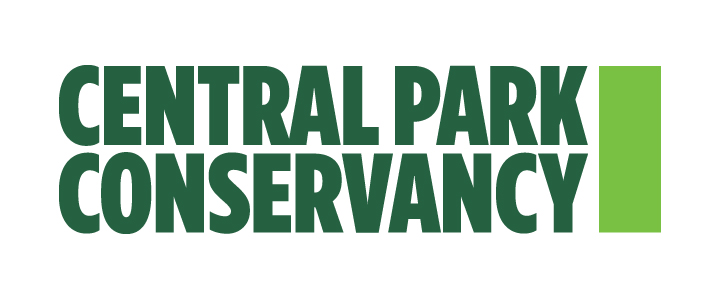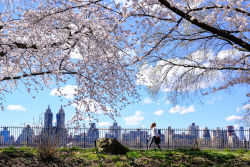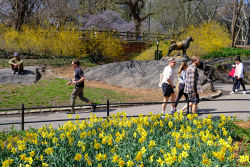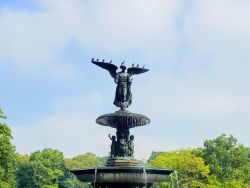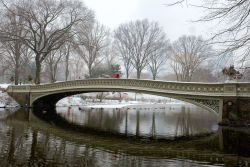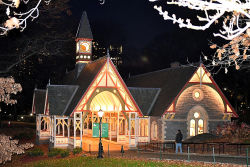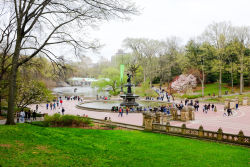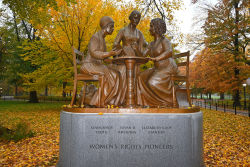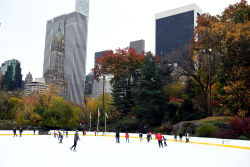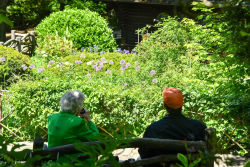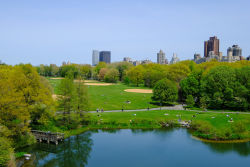Central Park
The Arsenal
The historic Arsenal is one of two buildings within Central Park that predate the park itself. (The other building is the block house, which dates from the War of 1812). The Arsenal was built between 1847 and 1851 by the State of New York as a storage repository for munitions; the previous state arsenal had been located in Madison Square Park. The project’s funding was overseen by state comptroller Millard Fillmore, who later became President of the United States.
The Arsenal’s architect was Martin E. Thompson (1786-1877), whose work includes the Old Assay Office in Lower Manhattan, and the Marshall Mansion, a Greek-Revival mansion which formerly stood in Pelham Bay Park. For this commission Thompson designed a fortress-like structure, with a crenelated cornice and rooftop turrets. Over the doorway was placed a cast-iron eagle, one of numerous copies manufactured in 1851 by the Daniel Meeker Foundry of Newark, New Jersey.
The building’s military use proved short-lived. Between 1853 and 1856, the State seized the land beneath it for a public park. In 1857 the City purchased the Arsenal for $275,000, removed all arms, and established park administrative functions on the premises. Some park advocates recommended its removal; diarist George Templeton Strong considered it a “hideous” blight on the landscape.
The Arsenal, however, remained. Over the ensuing decades it has served diverse roles. In 1857 the 11th Police Precinct was stationed here. In 1859 the Menagerie (later the zoo) was created in and around the Arsenal. When the American Museum of Natural History was founded, its first home was the Arsenal, from 1869 to 1877; also at that time B. Waterhouse Hawkins, an eminent British paleontologist, set up a studio on the second and third floors, where he reconstructed dinosaur skeletons.
A gallery of art occupied the first floor in the early 1870s, and the Municipal Weather Bureau’s instruments were kept on the Arsenal roof from 1869 to 1918. Through these years, the interior underwent extensive remodeling to accommodate changing uses, including a restaurant. Yet the years took their toll and the building’s stability declined. From 1914 to 1924 the Manhattan Parks Department vacated the premises, in favor of the newly built Municipal Building, and in 1922, the New York Times declared in a headline, “Parks Arsenal a Near Ruin.”
Though the building was a candidate for demolition, the City gave the Arsenal a $75,000 renovation, completed in 1924, which added central turrets, as well as a clock facing the zoo. When Robert Moses (1888–1981) was appointed the first citywide Parks Commissioner in 1934, the Arsenal again underwent extensive renovation and the original stucco was removed from the exterior brickwork. Lavish murals inspired by images of old New York in the lobby were part of a 1935-36 Works Progress Administration project by artist Allan Saalburg (1899-1987) and a team of assistants. The front entrance was also redesigned to include military-style decorative drums over the door, and cast-iron musket replicas supporting the banisters.
In 1967, the Arsenal was designated an official city landmark. Since 1976 the central chamber on the third floor has been used as a public gallery. The Conference Room once held the original Greensward Plan submitted by Frederick Law Olmsted and Calvert Vaux, which won the design competition for Central Park. In 2016 the original plan was transferred to the New York City Municipal Archives and in 2018 a scale replica was installed in the Conference Room. Today the historic Arsenal is home to Parks’ central administration, the Historic House Trust, the City Parks Foundation, and the Wildlife Conservation Society. The Parks’ Library and the office of the Parks historian are also housed here.
Check out your park's Vital Signs
Clean & Safe
Green & Resilient
Empowered & Engaged Users
Share your feedback or learn more about how this park is part of a
Vital Park System
Contacts
Central Park Information: (212) 310-6600
Central Park Information (for the Hearing Impaired): (800) 281-5722
Belvedere Castle, The Henry Luce Nature Observatory: (212) 772-0210
The Charles A. Dana Discovery Center: (212) 860-1370
The Dairy Visitor Center and Gift Shop: (212) 794-6564
North Meadow Recreation Center: (212) 348-4867
Loeb Boathouse (Bike rentals, boat rentals & gondolas): (212) 517-2233
Carousel: (212) 879-0244
Fishing at Harlem Meer (Catch & Release): (212) 860-1370
Harlem Meer Performance Festival: (212) 860-1370
Horseback Riding - Claremont Stables: (212) 724-5100
Metropolitan Opera (Performances on the Great Lawn): (212) 362-6000
New York Philharmonic (Performances on the Great Lawn): (212) 875-5709
Shakespeare in the Park - The Public Theater at the Delacorte Theater: (212) 539-8655
Central Park SummerStage: (212) 360-2777
Swedish Cottage Marionette Theater: (212) 988-9093
Tennis: (212) 280-0205
Weddings, Ceremonies and Photography at the Conservatory Garden: (212) 360-2766
Wildlife Center & Tisch Children's Zoo: (212) 439-6500

